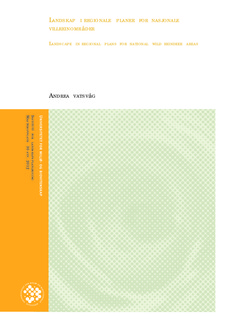Landskap i regionale planer for nasjonale villreinområder
Master thesis

Permanent lenke
http://hdl.handle.net/11250/188361Utgivelsesdato
2012-09-19Metadata
Vis full innførselSamlinger
- Master's theses (ILP) [763]
Sammendrag
Landskapsforståelsen har endret seg fra å være forbundet med vern til å bli fokusert på som en dynamisk
møteplass og som en ressurs i planlegging og forvaltning. Den europeiske landskapskonvensjonen
som kom i 2004, bragte med seg nye holdninger til landskapet og bidrar til å få landskapets viktighet
i planlegging og forvaltning fram. I denne oppgaven er det blitt sett på landskapets stilling i regionale
planer for nasjonale villreinområder. De to regionale planene som er undersøkt er Regional plan for
Hardangervidda og Regional plan for Setesdal Vesthei Ryfylkeheiane og Setesdal Austhei («Heiplanen»).
De to regionale planene har sammenfallende grenser i Vinje kommune i Telemark fylke. Dette området
er derfor valgt som utgangspunkt for landskapsanalysen foretatt i oppgaven. Planene er utformet
forskjellig med forskjellige plankart som har ulike hensynssoner for videre utvikling og forvaltning av
planområdene. Dette er problematisk for Vinje kommune, som må forholde seg til ulike hensynssoner i
et sammenhengende landskap. Det er i denne oppgaven blitt sett på hvordan landskap har vært med i
prosessen fra starten, ved utsendelse av brevet om utførelsen av de regionale planene fra Miljøverndepartementet,
til prosessen hos prosjektledere i fylkeskommunene og i kommunene.
Metoden brukt i oppgaven er casestudiemetoden med dokumentstudie, intervju med aktuelle aktører i
de regionale planene og en landskapsanalyse i valgt eksempelområde.
Denne oppgaven viser at landskap fortsatt ofte bare blir sett på som noe man skal ta særlig vare på eller
verne, både av de aktuelle aktørene i intervjuene til oppgaven og i norsk lovgivning og politikk generelt.
Den viser også at landskap er noe som kan oppfattes som abstrakt for folk, og at det derfor trengs mer
fokus på og forklaringer av dette og forklaringer av hva landskapsanalyse er for at landskapsanalyse skal
bli oppfattet som et nyttig verktøy i planlegging og forvaltning.
I de regionale planene det er sett på i denne oppgaven er landskap i liten grad integrert, noe som krever
endring av holdninger til og fokus på temaet for å holde landskapskonvensjonen og andre nasjonale
målsetninger i Norge. The understanding of landscape has changed from being associated with protection to be focused on as a
dynamic meeting place and as a resource in planning and management. The European Landscape Convention,
which came in 2004, brought new attitudes to the landscape. The convention also contributes to
promote the landscape in planning and management. In this master thesis the status of landscape in regional
plans for national wild reindeer areas has been looked into. The two regional plans that have been
looked into is Regional Plan for Hardangervidda and Regional Plan for Setesdal Vesthei Ryfylkeheiane og
Setesdal Austhei ("Heiplanen").
The two regional plans have concurrent borders in Vinje municipality in Telemark county. This area has
been chosen as the basis for landscape analysis undertaken in this thesis. The plans are not alike and
have different maps with different zones for further development and management of the area. This is
problematic for Vinje municipality, which must deal with the various zones in a continuous landscape.
In this thesis it has been looked into how landscape has been involved in the planning process from the
beginning, to the sending of the letter from the Ministry of the Environment (Miljøverndepartementet)
about how to make these regional plans, to the working process of the project managers in the county
municipalities and in the municipalities.
The method used in this thesis is a case study with document study, interviews with relevant actors in the
regional plans and a landscape analysis in a selected area.
This thesis shows that landscape is still often seen as something that one should take particular care of
or protect, both by the relevant actors in the interviews and in the Norwegian law and politics in general.
It also shows that landscape is something that can be perceived as abstract to people, and therefore it is
necessary with more focus on and explanations of this and of what landscape analysis is, so that landscape
analysis will be perceived as a useful tool in planning and management.
In the regional plan that has been looked into in this thesis the landscape theme has been integrated
to only a small degree. This requires changes in the attitudes to and focuses on the theme to follow the
Landscape Convention and other national objectives in Norway.